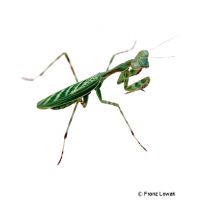African Pinstripe Mantis (Miomantis binotata)
| African Pinstripe Mantis Miomantis binotata | |
|---|---|
| Name | African Pinstripe Mantis |
| Name Lat. | Miomantis binotata |
| Family | Miomantid Mantises |
| Family lat. | Miomantidae |
| Order | Praying Mantids |
| Order lat. | Mantodea |
| Origin | Southeast Africa |
| Habitat | Savanna |
| Diet | Flying insects |
| Humidity | 50-60 % |
| Behavior | Predatory |
| Keeping | Individual |
| Care Level | Easy |
| Housing | Dry terrarium |
| Breeding | Moderately difficult |
| Life Span | 3-6 months |
| Protection | No |
| Metric Units | |
| Size | 3-4 cm |
| Temperature Day | 25-30 °C |
| Temperature Night | 20-22 °C |
| Housing Size | 20 x 20 x 30 cm |
| US Units | |
| Size | 1.2"-1.6" |
| Temperature Day | 77-86 °F |
| Temperature Night | 68-72 °F |
| Housing Size | 10" x 10" x 10" |
Distribution and habitat
The distribution area of the diurnal variegated dwarf mantis is in eastern Africa (Kenya, Tanzania) and South Africa. They inhabit the dry savannas, where they live mainly on flowering shrubs and on grasses.
Maintenance
For a female an insectarium of 20 x 20 x 30 cm (L x W x H), for a group of up to 5 males 30 x 30 x 50 cm, can be recommended as a guideline, which should be placed in a quiet place without direct sunlight. A cover of gauze or fine metal mesh is recommended
You need an insectarium not too densely structured with sufficiently thin climbing branches (hiding places, visual protection) and grasses, a substrate of sand-earth mixture (terrarium humus) and moss, and a small, shallow drinking vessel with water gel or a absorbent cotton drinker. Artificial or live plants are suitable for decoration
The insectarium should be finely sprayed with water lightly inside every 2-3 days, preferably in the evening. Too much moisture is not tolerated.
| Temp. day: 25-30 °C | Temp. night: 20-22 °C | Humidity: 50-60 |
The lighting duration should be 12 hrs. Light sources that also produce the necessary heat are ideal.
Diet
They are predatory and seize the prey, preferably flying insects, with lightning speed from an angled lying-in-wait position with their tentacles. The food supply should consist of crickets, house crickets, flies (Drosophila) and wax moths, small butterflies as well as cockroaches and small grasshoppers etc.. It is important to regularly add minerals and vitamins (e.g. by dusting the feeders). The quality of the feeders can be enhanced by feeding overripe fruit and honey water. A few days before, during and after molting, they refuse to eat. During molting, no predatory feeders (e.g. crickets) should remain in the insectarium, as during this time the animals are unprotected and may become prey themselves.
A varied diet promotes health and prevents deficiency symptoms.
Reproduction and breeding
The slightly larger and stouter flightless females have green and white striped wings, while the solid green, slightly translucent wings of the males are longer and extend beyond the abdomen.
About 4-10 days after mating, which lasts several hours, the female gradually lays 5-10 egg packages (oothecae) usually on branches in a well-camouflaged manner. An ootheca is about 0.5-1 cm in size and about 3 mm thick. After about 4-6 weeks at a temperature of about 26-28 °C about 30-60 nymphs hatch, sometimes much more
After imaginal molting, males are ready to mate after about a week, females after 3-4 weeks. After that the males live about 3 months, the females up to 6 months
Important
Prior to mating, a large food animal should be offered to the female to reduce the risk of her eating the male. It is recommended to keep females singly.
They have very good camouflage (mimesis) due to their body shape and coloration and their often prolonged immobility.
Before purchasing, an insectarium should be prepared that meets the species specific needs. Good ventilation without drafts is necessary, as well as equipment for measuring temperature and humidity. The lighting should correspond to the species-specific day-night rhythm and should be placed in such a way that the animals cannot injure themselves. The insectarium should be locked in such a way that neither unauthorized persons can open it nor the animals can escape. Special attention must be paid to thorough hygiene and contamination must be removed regularly.
Further literature can be found in your pet store.
References
Text: petdata; Image: Franz Lowak
Source: HENKEL & SCHMIDT (2010): Taschenatlas Wirbellose für das Terrarium, Verlag Ulmer; ENGELMAN & LANGE (2011): Zootierhaltung - Tiere in menschlicher Obhut: Wirbellose, Verlag Harri Deutsch
